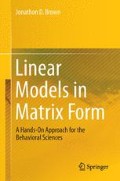Abstract
In previous chapters, you learned that the errors in a linear regression model are assumed to be independent and normally and identically distributed random variables, with mean 0 and variance σ 2:
We discussed the normality assumption in Chap. 6, learning ways to determine whether the errors are normally distributed (e.g., QQ plot, Jarque-Bera test) and the steps we can take to normalize them if they are not (e.g., Box-Cox transformation). In this chapter, we will consider whether the errors are independent and identically distributed, learning ways to assess these assumptions and correct violations of them when they arise.
Access this chapter
Tax calculation will be finalised at checkout
Purchases are for personal use only
Notes
- 1.
In some textbooks, heteroscedasticity is spelled heteroskedasticity.
- 2.
- 3.
To illustrate, if we had three original predictors, we would have nine predictors for White’s test (i.e., three original predictors, three squared predictors, and three pairwise cross product terms). Note that we do not compute higher-order cross product terms, only pairwise ones, and we do not square dummy-coded variables (see Chap. 11). Finally, the general rule is that there will be \( 2k+\frac{(k)\left(k-1\right)}{2} \) predictors in the equation.
- 4.
A third approach, which should always be considered before a statistical one, is to rethink our regression model to be sure we have included all relevant variables.
- 5.
Because we have not included a true intercept, we do not interpret the R 2 value from the transformed data.
- 6.
In some textbooks, autocorrelations are referred to as “serial correlations.” There is no substantive difference between the terms, but I prefer “autocorrelation” because it underscores that the residuals are correlated with themselves.
- 7.
Notice that we cannot find the difference score for the first observation because there is no preceding error to subtract. Consequently, we will have N − 1 observations when performing this test.
- 8.
Spreadsheet functions can be used to perform these operations. To illustrate, if the vector of residuals lies in “e3:e14,” the following command produces the Durbin-Watson statistic: SUMXMY2(e3:e13,e4:e14)/SUMSQ(e3:e14).
- 9.
Notice that we have entered a 0 for our first lagged residual. Alternatively, we can omit the observation entirely, performing the analysis on t − 1 observations. In this case, we multiply R 2 by t − 1. Using this method with our data, we find that χ 2 = 5.8925, p = .0152.
- 10.
The procedure goes by a variety of other names, including estimated generalized least squares, the Cochrane-Orcutt method, and the Yule-Walker method. There are slight differences among these procedures, but they all estimate the magnitude of the autocorrelation parameter.
- 11.
I have left the top half of each matrix empty to make it easier to see how the weights are constructed, but each matrix is symmetrical, so the top half is the transpose of the bottom half.
References
Breusch, T. S., & Pagan, A. R. (1979). Simple test for heteroscedasticity and random coefficient variation. Econometrica, 47, 1287–1294.
Fox, J. (2008). Applied regression analysis and generalized linear models (2nd ed.). Newbury Park: Sage.
Hayes, A. F., & Li, C. (2007). Using heteroscedasticity-consistent standard error estimators in OLS regression: An introduction and software implementation. Behavior Research Methods, 37, 709–722.
Long, J. S., & Ervin, L. H. (2000). Using heteroscedasticity consistent standard errors in the linear regression model. The American Statistician, 54, 217–224.
Newey, W. K., & West, K. (1987). A simple, positive semi-definite, heteroskedasticity and autocorrelation consistent covariance matrix. Econometrica, 55, 703–708.
White, H. (1980). A heteroskedasticity-consistent covariance matrix estimator and a direct test for heteroskedasticity. Econometrica, 48, 817–838.
Author information
Authors and Affiliations
7.1 Electronic Supplementary Material
Rights and permissions
Copyright information
© 2014 Springer International Publishing Switzerland
About this chapter
Cite this chapter
Brown, J.D. (2014). Errors and Residuals. In: Linear Models in Matrix Form. Springer, Cham. https://doi.org/10.1007/978-3-319-11734-8_7
Download citation
DOI: https://doi.org/10.1007/978-3-319-11734-8_7
Published:
Publisher Name: Springer, Cham
Print ISBN: 978-3-319-11733-1
Online ISBN: 978-3-319-11734-8
eBook Packages: Mathematics and StatisticsMathematics and Statistics (R0)

